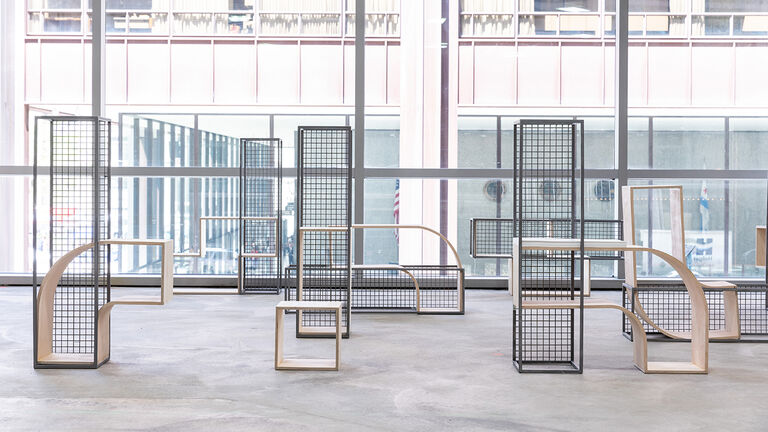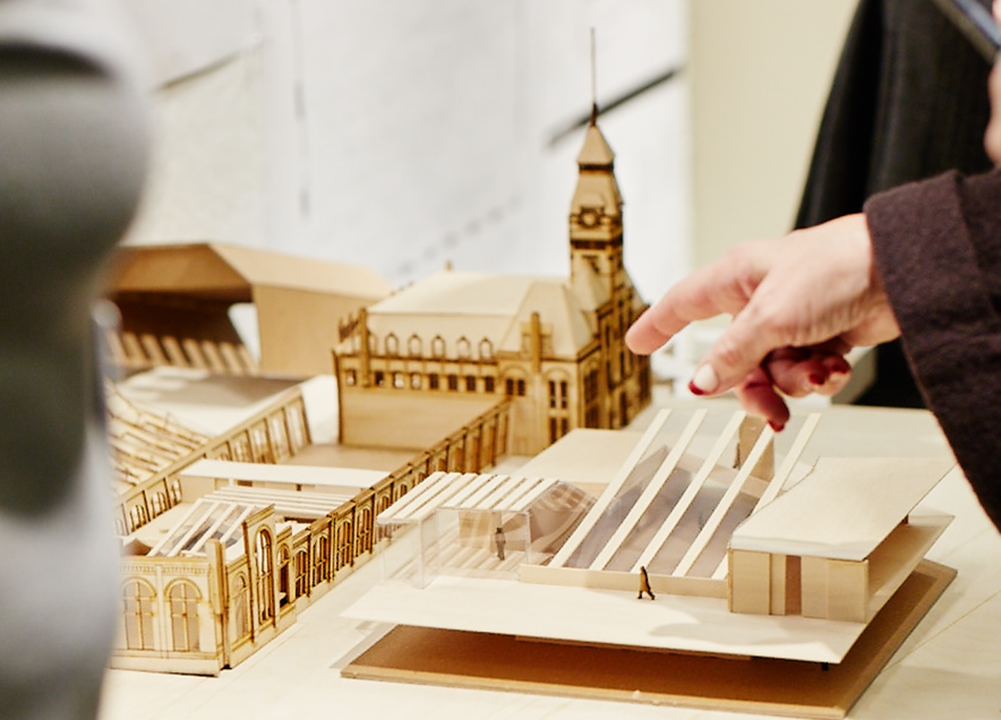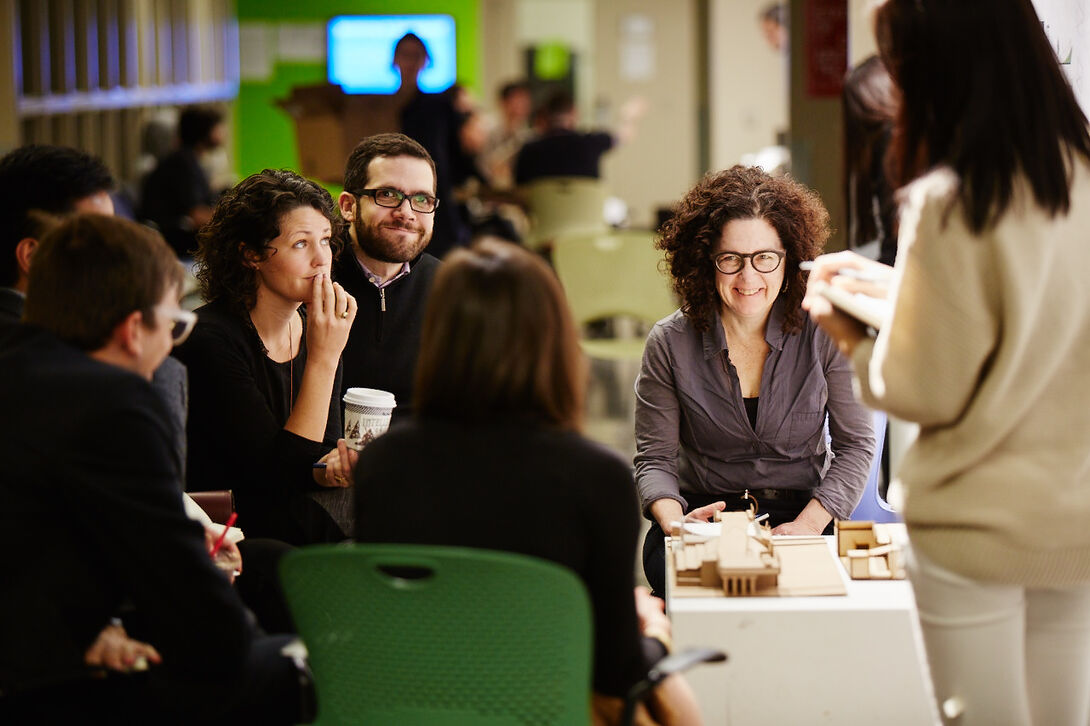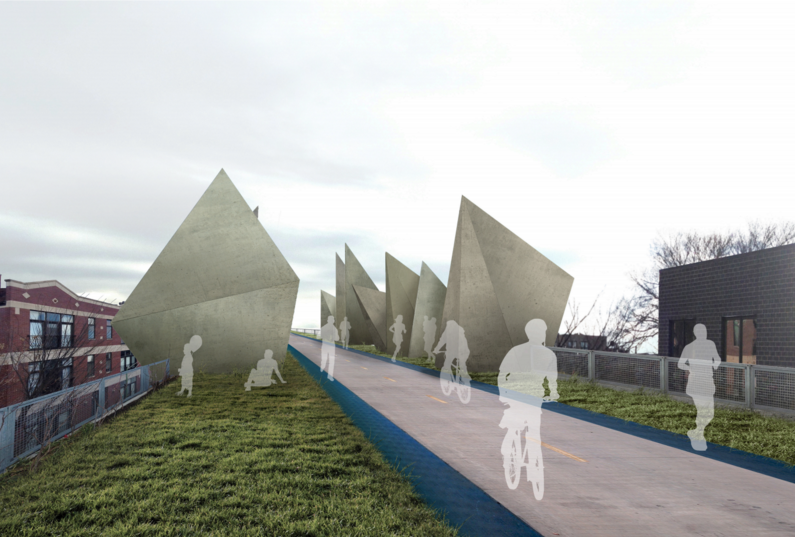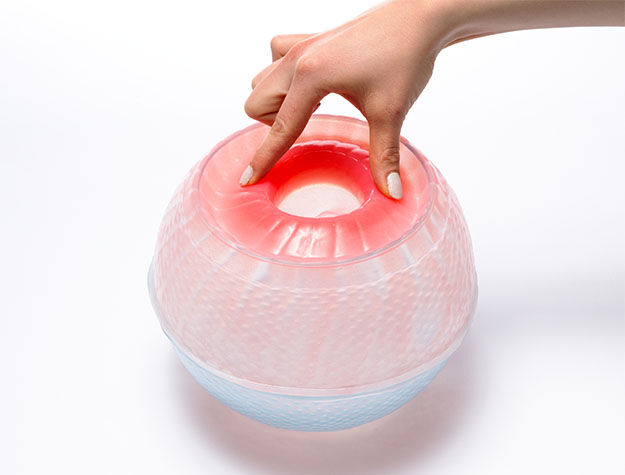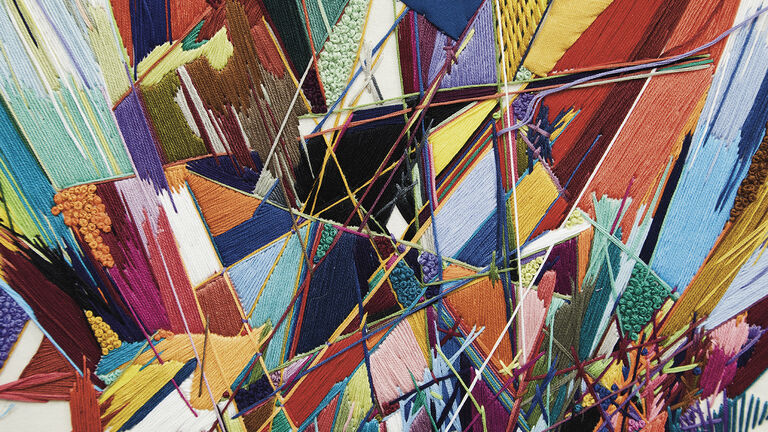| Introduction to Designed Objects |
1001 (001) |
Cassandra Scanlon |
Mon
9:00 AM - 3:00 PM
In Person
|
|
Description
This course introduces students to the creative scope of the Designed Objects program, and the ideas, skills, and methods used in the process of designing objects. Students will learn about the design of objects by studying their form, function, assembly, materiality, use, value and significance (both subjective and objective). Emphasizing thinking through making; students students build their visual vocabulary and develop an understanding of the design process. The goal of this class is to help students imagine the possibilities of the object design field and identify their aptitude for becoming an object designer. The course will explore the intentionality of object design, exploring the works of a ranging from James Dyson to Ron Arad to Zaha Hadid. Readings and screenings will vary but typically include Mu-Ming Tsai's Design Thinking and Gary Hustwit's Objectified. Students should expect to produce a body of work consisting of several minor exploratory projects and two fully fleshed out finished Objects (mid-term and final). This course requires students to have a laptop that meets SAIC's minimum hardware specs and runs the AIADO template.
|
Class Number
1142
|
Credits
3
|
Department
Architecture, Interior Architecture, and Designed Objects
Area of Study
Product Design
Location
Sullivan Center 1255
|
| Introduction to Designed Objects |
1001 (002) |
Sara Prado |
Wed
9:00 AM - 3:00 PM
In Person
|
|
Description
This course introduces students to the creative scope of the Designed Objects program, and the ideas, skills, and methods used in the process of designing objects. Students will learn about the design of objects by studying their form, function, assembly, materiality, use, value and significance (both subjective and objective). Emphasizing thinking through making; students students build their visual vocabulary and develop an understanding of the design process. The goal of this class is to help students imagine the possibilities of the object design field and identify their aptitude for becoming an object designer. The course will explore the intentionality of object design, exploring the works of a ranging from James Dyson to Ron Arad to Zaha Hadid. Readings and screenings will vary but typically include Mu-Ming Tsai's Design Thinking and Gary Hustwit's Objectified. Students should expect to produce a body of work consisting of several minor exploratory projects and two fully fleshed out finished Objects (mid-term and final). This course requires students to have a laptop that meets SAIC's minimum hardware specs and runs the AIADO template.
|
Class Number
1143
|
Credits
3
|
Department
Architecture, Interior Architecture, and Designed Objects
Area of Study
Product Design
Location
Sullivan Center 1241
|
| Introduction to Architecture/Interior Architecture |
1001 (002) |
Jaak Jurisson |
Thurs
9:00 AM - 3:00 PM
In Person
|
|
Description
Introduces the meaning and making of architecture and interior architecture through individual and group design projects. Students learn design processes by experimenting with materials and exploring architectural and interior architecture representation, and measure the implications of their work on broader cultural contexts. Students work on design projects using the latest software and digital tools, and develop techniques for integrating analog and digital design and fabrication processes. Students research historic precedents and contemporary culture and design to inform their work. This course requires students to have a laptop that meets SAIC's minimum hardware specs and runs the AIADO template.
|
Class Number
2374
|
Credits
3
|
Department
Architecture, Interior Architecture, and Designed Objects
Location
Sullivan Center 1231
|
| Arch/Inarch: Design Drawing |
1002 (001) |
Aaron Neal |
Tues
9:00 AM - 3:00 PM
In Person
|
|
Description
This course is a comprehensive introduction to two-dimensional architectural and interior architectural representation. Students learn hand-drawing and digital techniques to produce orthographic, axonometric, isometric, and perspectival projections in individual and group projects. Students move between two- and three-dimensional representation, developing robust skills for design drawing. Typically the course will review the work of architects and designers throughout the history of architecture representation. Readings will vary and focus will be concentrated on understanding and putting into practice the mechanisms of drawing. Course work consists of building techniques and practice of drawing. Classes will develop incremental skills through assignments and projects that culminate into complex drawings and representations. This course requires students to have a laptop that meets SAIC's minimum hardware specs and runs the AIADO template.
|
Class Number
2268
|
Credits
3
|
Department
Architecture, Interior Architecture, and Designed Objects
Area of Study
Digital Communication
Location
Sullivan Center 1407
|
| Arch/Inarch: Design Drawing |
1002 (002) |
Jaak Jurisson |
Fri
9:00 AM - 3:00 PM
In Person
|
|
Description
This course is a comprehensive introduction to two-dimensional architectural and interior architectural representation. Students learn hand-drawing and digital techniques to produce orthographic, axonometric, isometric, and perspectival projections in individual and group projects. Students move between two- and three-dimensional representation, developing robust skills for design drawing. Typically the course will review the work of architects and designers throughout the history of architecture representation. Readings will vary and focus will be concentrated on understanding and putting into practice the mechanisms of drawing. Course work consists of building techniques and practice of drawing. Classes will develop incremental skills through assignments and projects that culminate into complex drawings and representations. This course requires students to have a laptop that meets SAIC's minimum hardware specs and runs the AIADO template.
|
Class Number
2269
|
Credits
3
|
Department
Architecture, Interior Architecture, and Designed Objects
Area of Study
Digital Communication
Location
Sullivan Center 1241
|
| Arch/Inarch: Ugrd Studio 2 |
2002 (001) |
Keefer Dunn |
Mon/Wed
9:00 AM - 3:00 PM
In Person
|
|
Description
ARCH/INARC Studio 2 is a two-day core design studio that expands the architecture and interior architecture design skills and research capabilities explored in Studio 1. Design projects of increasing complexity and scale are generated, critiqued and refined. Research includes contemporary architecture, site research, urban context, and critical design issues of theory and construction. Students utilize hand sketching, digital visualization, photography, and physical modeling to present design project work with expanding sophistication. This course requires students to have a laptop that meets SAIC's minimum hardware specs and runs the AIADO software template.
Prerequisites
Pre:ARCH/INARC 2001
|
Class Number
2270
|
Credits
6
|
Department
Architecture, Interior Architecture, and Designed Objects
Location
Sullivan Center 1406B
|
| Arch/Inarch: Ugrd Studio 2 |
2002 (002) |
Hennie Jurie Reynders |
Mon/Wed
9:00 AM - 3:00 PM
In Person
|
|
Description
ARCH/INARC Studio 2 is a two-day core design studio that expands the architecture and interior architecture design skills and research capabilities explored in Studio 1. Design projects of increasing complexity and scale are generated, critiqued and refined. Research includes contemporary architecture, site research, urban context, and critical design issues of theory and construction. Students utilize hand sketching, digital visualization, photography, and physical modeling to present design project work with expanding sophistication. This course requires students to have a laptop that meets SAIC's minimum hardware specs and runs the AIADO software template.
Prerequisites
Pre:ARCH/INARC 2001
|
Class Number
2271
|
Credits
6
|
Department
Architecture, Interior Architecture, and Designed Objects
Location
Sullivan Center 1406A
|
| Arch/Inarch: Light and Space |
2003 (002) |
Uthman Olowa |
Wed
9:00 AM - 3:00 PM
In Person
|
|
Description
Light is a miraculous condition both conceptually and physically in the fact that it is a medium which can not be touched or held, etc. Light in combination with space creates containers for the production of what can only be described as auras. The ephemeral conditions which light produces actually changes and alters the spaces we inhabit daily. The course Light & Space is designed to develop and expand both artistic and architectural sensibilities for students in the exploration of natural and artificial light as a medium. This one day a week studio is structured around a series of lectures about the comparison between Architects and Artists through exercises involving both physical and digital models within the city of Chicago. The exercises will introduce students on how to construct and assemble spaces in order to control light and the effects it has on inhabitants of architectural surroundings. The instructors of Light & Space present a series of case study comparisons between architects and artists as a means to open the possibilities for extreme experimentation within the studio setting. Students final project of the semester is the curation of the collection of imagery designed and rendered via all exercises, but open ended for each individual student?s interpretation and personal expression of social, political, and gender issues, etc. This course requires students to have a laptop that meets SAIC's minimum hardware specs and runs the AIADO template.
|
Class Number
2367
|
Credits
3
|
Department
Architecture, Interior Architecture, and Designed Objects
Location
Sullivan Center 1255
|
| Sketching for Designed Objects |
2005 (003) |
|
Fri
9:00 AM - 3:00 PM
In Person
|
|
Description
This course will provide the student with the skills to create design concept sketches (ideation/thinking) that will communicate with the viewer and visualize the design concept as a design object using sketch renderings to define and communicate the object's form and function. Instructions will focus on freehand marker sketching for ideation/thumbnails, shading, form development and rendering, followed by orthographic projection (measured technical drawing) and two-point perspective. Each of these skills will be demonstrated in class and on a one to one basis during the semester In each class I will share design drawings from my collection that show a history of sketching styles for presentations using Prismacolor Pencils and NuPastels to markers, along with marker drawings for clients that I and other designers have created in product, packaging and display projects. These presentations will also be used to lecture on the history of design drawing styles and techniques. Students will be given three design projects in which they will go through the design process of starting with ideation sketches, followed by design selection, renderings and an orthographic drawing of the final design. The first project focuses on the development of forms, the next two projects have an emphasis on ideas and drawing skills. This course requires students to have a laptop that meets SAIC's minimum hardware specs and runs the AIADO template.
|
Class Number
1164
|
Credits
3
|
Department
Architecture, Interior Architecture, and Designed Objects
Area of Study
Product Design
Location
Sullivan Center 1255
|
| Designed Objects Studio One |
2020 (001) |
Erik Newman |
Tues
9:00 AM - 3:00 PM
In Person
|
|
Description
As the beginning course in the Designed Objects department, students will have an opportunity to explore different methods of working in order to begin establishing a practice that works best for them. Students will be building a strong foundation of skills and techniques needed to navigate an informed design process and successfully complete a design brief. In this hands-on class, students will learn how to find inspiration for an idea, develop that idea into a concept, and use that concept to design and fabricate a high-level, final prototype. Basic research theories and methods are introduced which are then applied towards studio projects. Fabrication and prototyping techniques are also incorporated in order to test out ideas and discover new ones. Students advance through definition, research, ideation, sketching, and modeling phases toward two? and three?dimensional representations (digital and physical) of their work that are orally defended during group critique. Readings and lecture content will vary and will focus on examples of historically relevant and contemporary designers, artists, studios, and design movements; as well as design practices that highlight different motivations of the designer. In addition to the two main projects that focus on different methods of approaching design? where students will be producing high-level prototypes, this workshop-style class consists of one-day projects and exercises designed to introduce techniques and skills such as technical drawing and sketching, form-finding, prototyping, and inspiration research, among others. This course requires students to have a laptop that meets SAIC's minimum hardware specs and runs the AIADO template.
Prerequisites
Prerequisite: Sophomore-level or above.
|
Class Number
1145
|
Credits
3
|
Department
Architecture, Interior Architecture, and Designed Objects
Area of Study
Product Design
Location
Sullivan Center 1256
|
| Designed Objects Studio Two |
2030 (001) |
Annalee Koehn |
Thurs
9:00 AM - 3:00 PM
In Person
|
|
Description
We will work with the processes by which product designers develop compelling objects that communicate ideas, values, functions and purpose. Projects are designed to study the language of form through an analysis of user interaction, the implications of material choice, finishes, and craftsmanship on the success of a product concept, and how these choices support and promote function, desirability and perceived value. There is also an emphasis on expanding student material exploration and making techniques for optimal results, and the value of iterative prototyping in a successful design process. The course will address universal product design issues and methods, starting with defining and understanding the project, considering form and function, appropriate material selection, construction techniques, finishes, iteration, and well-crafted final products. We will cover concepts such as semiotics, ergonomics, families of objects, multi-functional products, and emphasize clear communication of finished design ideas through schematics, and graphic representation using descriptive photography. Relevant contemporary design examples are provided as reference for each project, and students will spend additional time researching contemporary designers such as Front Design, Raw Edges, Nendo and Ron Arad. Students will be introduced to high-end professional design sources in a business setting through a field trip to the Merchandise Mart. The course is built around 3 main projects, each with instructional presentations, Design research assignments, ideation and sketching, group discussions, and iterative prototyping, resulting in the creation of a final product and printed graphic document, all presented and discussed in a group critique. This course requires students to have a laptop that meets SAIC's minimum hardware specs and runs the AIADO template.
Prerequisites
Pre Req: DES OB 2020
|
Class Number
1146
|
Credits
3
|
Department
Architecture, Interior Architecture, and Designed Objects
Area of Study
Product Design
Location
Sullivan Center 1241
|
| Sustainability Studio |
2035 (001) |
Peter J Zerillo |
Tues
3:30 PM - 6:15 PM
In Person
|
|
Description
This course provides an introduction to sustainable design, covering topics such as raw materials, energy, food, water, global and local production, global supply chain, green chemistry, and circular economies. Students will learn about the three pillars of sustainability and the fundamental concepts and principles of sustainability. The course will cover the importance of renewable resources and closed-loop systems to reduce waste in sustainable design. Students will explore renewable energy sources and energy-efficient technologies. The importance of food and water in sustainable design, global and local production systems, the precautionary principle, and the ethical sourcing of materials will also be covered. The course will examine green chemistry as a means of reducing the environmental impact of chemical processes. Finally, students will learn about circular economies and the importance of designing products and processes that promote the reuse and recycling of materials. By the end of the course, students will be able to apply their knowledge of sustainable design principles and practices to their projects in and out of school.
Prerequisites
Prerequisite: Sophomore-level or above.
|
Class Number
2223
|
Credits
3
|
Department
Architecture, Interior Architecture, and Designed Objects
Area of Study
Product Design, Sustainable Design
Location
Sullivan Center 1241
|
| Digital Modeling: Rhino |
2124 (001) |
Peter J Zerillo |
Mon/Wed
6:45 PM - 9:15 PM
In Person
|
|
Description
This course is designed to be a fast-paced first step into the field of 3D CAD modeling, an arena where designers give shape to our daily experience of the world. If this is your first exposure to virtual 3D form development, you will find a flexible interface that facilitates a rapid learning curve from simple to complex. For those with prior CAD experience desiring a more intuitive, less restrictive creative experience, this course will provide the means to turn what you see in your mind and your sketches into exciting visual and precise physically accurate representations of your vision. Throughout the semester we will discuss historical and current events in product, fashion and architectural design. Typically, these shared conversations lead to discoveries that participants dig into and apply to assignments. A list of influential artists, designers and architects is provided along with suggested books and online references that enrich and add diversity and range to our discourse. Initially, the class works through a series of exercises and tutorials designed to bring familiarity and confidence to their experience with Rhino. Students will investigate methods for surfacing, modifying, rendering, and presenting ideas and concepts they create. As each tool and process becomes more familiar, new methods and strategies are introduced, and students are taught how to apply them to create accurate representative models of objects they design. In addition to gaining hands-on skills, we will explore form creation and the physical, cognitive, emotional, social, and cultural factors that play into the development of a successful new product.
|
Class Number
1147
|
Credits
3
|
Department
Architecture, Interior Architecture, and Designed Objects
Area of Study
Digital Communication, Product Design
Location
Sullivan Center 1226
|
| Digital Modeling: Solidworks |
2126 (001) |
Angie Lullie |
Tues
3:30 PM - 9:15 PM
In Person
|
|
Description
This course introduces students to SolidWorks, a powerful parametric software package used by product designers to model, indicate specifications, and visualize their design intent. Students will learn the software in the context of design by using it as a tool to develop form and scale, convey design intent with 3D renders, create specification drawings for manufacturing, and interface with 3d printers, CNC machines, and laser cutters for quick iterative prototyping. This course will focus on a series of tutorials followed by hands-on design projects that will provide intensive training in 3D modeling, 3D printing, and photo-realistic 3D rendering.This will allow the students to make judgements on which 3D tools to use at what stage to develop the most efficient models. The tools will be explained through examples and demonstrations, which will allow the students to practice the tools during class. Students are expected to complete 4 projects. The projects will include learning 2D sketch tools and creating relations through existing logos, modeling existing products with multiple components, developing an original design based on an existing brand or artist, and collaborating within a group on a system of objects.
|
Class Number
1155
|
Credits
3
|
Department
Architecture, Interior Architecture, and Designed Objects
Area of Study
Product Design
Location
Sullivan Center 1226
|
| architectural design as a cultural practice |
2900 (001) |
Aaron Neal |
Thurs
3:30 PM - 6:15 PM
In Person
|
|
Description
What does a designer do? This course understands architectural design as a creative practice, embedded within rich cultures of disciplinary knowledge and professional responsibilities. As a creative practice, design becomes more than problem-solving and client management and embraces complex logics of possibility. The work of contemporary architects and related designers, such as Teddy Cruz+Fonna Forman, Brian C. Lee, Virgil Abloh, AGENdA , Jennifer Bonner, Shohei Shigematsu, and Li Hu and Huang Wenjing (OPEN), among others, will provide a reference point for our work. Students will experiment with practice scenarios, designed from and through their work, and the work of others in the class and in the field. Course projects will include a portfolio and a series of design writing experiments that will result in a critical essay, a designer's statement, and an academic map that will help students align SAIC's BFA programs with their interests and ambitions.
Prerequisites
Prerequisite: Must be a sophomore to enroll.
|
Class Number
1916
|
Credits
3
|
Department
Architecture, Interior Architecture, and Designed Objects
Location
Sullivan Center 1255
|
| Short Form |
2900 (002) |
|
Thurs
6:45 PM - 9:30 PM
In Person
|
|
Description
How might one see their creative practice from novel or surprising perspectives? What methodologies reliably yield diverse viewpoints on one’s work and process as an artist, designer, or scholar? This sophomore seminar invites students to engage with a versatile toolkit of short-form practices (epigrams, aphorisms, proverbs, taglines, haikus, titles, captions, jokes, epitaphs, diagrams, charts, cartoons, icons, pictograms, caricatures, logos, maps) to develop a kaleidoscopic repertoire of sketchbook-based frames of thought. Through a discipline of playful short-form probings we will foster critical perspectives that inform and support our creative practices, connecting with each other in an open forum and working to align the curriculum and resources of SAIC behind a self-directed course of study.
Prerequisites
Prerequisite: Must be a sophomore to enroll.
|
Class Number
1917
|
Credits
3
|
Department
Architecture, Interior Architecture, and Designed Objects
Location
Sullivan Center 1240
|
| Designing Your Future |
2900 (003) |
Anjulie Rao |
Tues
6:45 PM - 9:30 PM
In Person
|
|
Description
This seminar introduces students' to design problem definition, design process and the logic behind design problem frameworks. The arguments are grounded through an understanding of design criticism and by looking at foundational historic and contemporary convergences in critical design thinking. The seminar is specifically conceived in conjunction with the second year core design studios and as the first part of a thread of knowledge aimed at substantiating the central role of design thinking in the undergraduate curricula.
Prerequisites
Prerequisite: Must be a sophomore to enroll.
|
Class Number
1918
|
Credits
3
|
Department
Architecture, Interior Architecture, and Designed Objects
Location
Sullivan Center 1240
|
| Storytelling for Designed Objects |
2900 (026) |
Cassandra Scanlon |
Thurs
3:30 PM - 6:15 PM
In Person
|
|
Description
What are the concerns that drive one's creative practice? How does one set the terms for its future development? Sophomore Seminar offers strategies for students to explore, reflect upon, and connect common themes and interests in the development of an emerging creative practice that will serve as the basis of their ongoing studies at SAIC and beyond. Students will examine historical and contemporary influences and contextualize their work in relation to the diverse art-worlds of the 21st Century. Readings, screenings, and field trips will vary each semester. Presentations by visiting artists and guest speakers will provide the opportunity for students to hear unique perspectives on sustaining a creative practice. One-on-one meetings with faculty will provide students with individualized mentorship throughout the semester. During interdisciplinary critiques, students will explore a variety of formats and tools to analyze work and provide peer feedback. The class mid-term project asks students to imagine a plan for their creative life and devise a self-directed course of study for their time at school. The course concludes with an assignment asking students to develop and document a project or body of work demonstrating how the interplay of ideas, technical skills, and formal concerns evolve through iteration, experimentation and revision. Prerequisite: Must be a sophomore to enroll.
Prerequisites
Prerequisite: Must be a sophomore to enroll.
|
Class Number
2224
|
Credits
3
|
Department
Architecture, Interior Architecture, and Designed Objects
Location
Sullivan Center 1407
|
| Alterfutures Studio |
3032 (001) |
Jessica Charlesworth |
Mon
9:00 AM - 3:00 PM
In Person
|
|
Description
AlterFutures Studio is a studio course in which students question received expectations about ‘the future’ and use design, writing and visualization methods to propose compelling alternatives. The course will allow students to think through, articulate, and bring to life, critical and provocative narratives for alternative futures. By studying the tools and approaches of speculative and critical design, and design fiction, alongside literary and cinematic forms of futuring, the course builds awareness in, and enables practice of, contemporary techniques used to communicate alternative futures. AlterFutures Studio will be made up of three projects to be presented in a culminating course critique with complimentary readings and discussions each focusing on a particular subject matter and approach relating to emerging technologies and potential impacts on society and culture. The works of designers and artists Dunne & Raby, Superflux, Atelier Van Lieshout, and Lucy Orta, Noam Toran, Extrapolation Factory, and Cohen Van Balen will act as primary points of reference for our explorations in this course. Students will create physical prototypes and use VR tools to develop artifacts and worlds that express their ideas.
|
Class Number
2034
|
Credits
3
|
Department
Architecture, Interior Architecture, and Designed Objects
Area of Study
Art and Science
Location
Sullivan Center 1240
|
| Multiples Studio |
3034 (001) |
Jess Giffin |
Wed
9:00 AM - 3:00 PM
In Person
|
|
Description
This interdisciplinary studio class investigates the intersection of printmedia, artists? multiples and packaging as an entry point into making and thinking about multiples as a format for studio production. The history of artists? multiples (loosely defined as small-scale editioned or multiply produced three-dimensional works) includes many examples that use, or appropriate, printed elements and packaging in some way. This history, along with our daily experience of packaging (the many boxes, folders, labels, pamphlets, flyers and cartons found in nearly every aspect of contemporary life) offers a wealth of connections to consider and work from. Students will be introduced to a range of printing and paper construction techniques within the Printmedia studio. These include plate-based lithography (with hand-drawn, digital and photo options) and pattern layout for packaging along with other selected tools and techniques. In addition, students will have the opportunity to use SAIC labs such as the Service Bureau and digital fabrication centers. Examples, short readings, and a visit to the Joan Flasch or other related collections will support project development and discussion. Students can expect to complete three to five projects and participate in two critiques.
|
Class Number
2493
|
Credits
3
|
Department
Architecture, Interior Architecture, and Designed Objects
Area of Study
Product Design
Location
280 Building Rm 221
|
